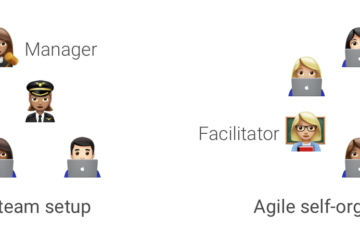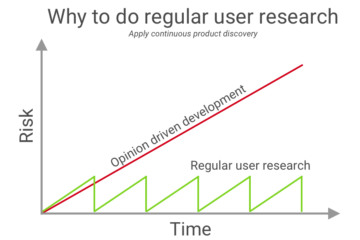Opportunity Assessment Review Review the Product Opportunity Assessment with the team and stakeholders to ensure that everyone understands the problem, the context, and how we will measure success.
⏰ 1 hour and more
Read more
Business Model Canvas Visualize a new business model idea—or rethink your company’s current business model—to highlight key drivers and create a shared understanding.
⏰ 15 minutes to several days
Read more
Lightning Demos Take a look at how competitors’ products are solving similar problems.
⏰ 10 minutes
Read more
Review Industry & Macro Research Know your markets, competitors, customer wants and needs, and what it takes to be competitive in your market.
⏰ 10 minutes
Read more
Proto-Personas Develop a set of quick, ad hoc personas that depict your customers (or those who are encountering this situation or problem).
⏰ 1 hour
Read more
Empathy Map Understand your customers within a given context by creating their profile based on what they think and feel, see and hear, and say and do.
⏰ 15-20 minutes
Read more
Pain-Gain Map Capture your users’ pains and gains to understand what motivates and influences their decisions.
⏰ 10-15 minutes
Read more
Value Proposition Canvas Map, think though, and discuss your value propositions and how they match your customers’ needs.
⏰ 45-90 minutes
Read more
Customer Journey Map Illustrate the steps your customers go through when engaging with your product or the company, and how they feel at various points along the way.
⏰ 10-15 minutes
Read more
Job Stories Identify opportunities for growth by deconstructing a job that customers are trying to get done.
⏰ 1 hour
Read more
Ethnographic Field Studies Sit back and silently observe customers use your product in their natural environment.
⏰ weeks
Read more
Contextual Inquiry Interviews Observe users interacting with your product or prototype, asking probing questions into the how and why of their actions.
⏰ weeks
Read more
Diary Studies Ask customers to keep a daily diary of not just how they use your product, but also their digital lives and habits.
⏰ weeks
Read more
Focus Groups Have a conversation between you and a group of your customers to understand their attitudes toward your product.
⏰ days
Read more
Site Intercept Surveys Present customers in the midst of using your product with a short, engaging survey.
⏰ hours
Read more
On-the-Street Surveys Hit the streets as a team and ask passers-by to take a moment out of their day to fill out a short survey.
⏰ hours
Read more
Moderated Usability Study Pose tasks and questions to your users to see how successfully they can interact with your product or prototype.
⏰ days
Read more
Unmoderated Usability Study Record users interacting with your product or prototype through webcam or screen recording to see how well they can perform tasks.
⏰ days
Read more
Problem Hypotheses Determine and state your most important assumptions about the user problem.
⏰ 45-60 minutes
Read more
5 W’s Answer the key questions of who, what, where, when, and why to understand the context of the problem you’re trying to solve.
⏰ 30- 90 minutes
Read more
Draw the Problem Do quick drawings to define the problem in a simple, clear, and compelling way.
⏰ 20-30 minutes
Read more
Fishbowl Focus on listening to have a more meaningful conversation—one group discusses the problem, while the other group listens and observes.
⏰ 40-45 minutes
Read more
The Five Whys Discover the root cause of a problem by drilling down below the surface to relate it to its context.
⏰ 1 hour and more
Read more
Challenge Cards Identify and think through challenges, problems, and potential pitfalls in a product, service, or strategy, then match them with solutions.
⏰ 30-60 minutes
Read more
Poster Session Communicate ideas and core concepts using images in a poster format to summarize a challenge or larger topic for further discussion.
⏰ 20 minutes
Read more
SWOT Analysis Evaluate your team’s likelihood of success relative to an objective by examining strengths, weaknesses, opportunities, dangers, and conditions that may affect your future.
⏰ 1-2 hours
Read more
Post the Path Define your group’s existing process at a high level and get a better understanding of the current process.
⏰ 30-60 minutes
Read more
Value Proposition Canvas Map, think though, and discuss your value propositions and how they match your customers’ needs.
⏰ 45-90 minutes
Read more
Tree Testing Find gaps between your product’s current navigation and what your users actually expect.
⏰ days
Read more
Stakeholder Interviews Reach out to stakeholders to uncover the varied business needs and motivations involving your product.
⏰ days
Read more
Go/No-Go Decision Discuss and decide whether the problem is a valid one to pursue further.
⏰ 1 hour
Read more
Mind Mapping Take your ideas, mix them with notes you’ve taken, and loosely organize them on paper.
⏰ 10-15 minutes
Read more
Post-Up Generate ideas individually about a given topic on sticky notes, then quickly present them to the group.
⏰ 10-60 minutes
Read more
6-8-5 Sketching Create 6 to 8 sketches in 5 minutes to get down initial ideas, generate many ideas, and iterate on the best ones.
⏰ 30-60 minutes
Read more
Brainwriting Generate multiple ideas individually, share them with each other, and then build on them together.
⏰ 30-45 minutes
Read more
Start, Stop, Continue Examine the current situation, goal, or product by brainstorming what you want to start doing, what should be stopped, and what works well now.
⏰ 10-60 minutes
Read more
The Anti-Problem When the team is running out of ideas for solutions for a problem, get unstuck by identifying ways to solve the opposite problem.
⏰ 30-45 minutes
Read more
Storyboarding Take the ideas you’ve generated so far, and sketch how a user would move through part of a user story.
⏰ 10-20 minutes
Read more
Elevator Pitch Use mad libs to create a compelling elevator pitch for your product, service, or idea.
⏰ 90 minutes
Read more
The VC Pitch Imagine you’re entrepreneurs pitching your idea to venture capitalists—present your key selling points, how the idea can make money, and why people will buy it.
⏰ 30-90 minutes
Read more
Participatory Design Bring your customers into the building to collaboratively build their perfect product with the team.
⏰ weeks
Read more
Silent/3-Min Critique Converge on the most promising storyboards using an individual critique followed by voting.
⏰ 5-10 minutes
Read more
Identify Conflicts Comb through your storyboards and look for conflicts—where there are two or more different approaches to solving the same problem.
⏰ 30-60 minutes
Read more
Design the Box Make focused decisions to design the package for an idea, which communicates information about its important features.
⏰ 1 hour plus
Read more
Affinity Map Discover embedded patterns of thinking by sorting and clustering information into relationships and similar categories.
⏰ 45-90 minutes
Read more
Impact & Effort Matrix Map and evaluate possible actions based on: 1) effort and cost required to implement, 2) potential impact (long-term vs. short-term payoff).
⏰ 30-60 minutes
Read more
Planning Poker Planning Poker is an estimating technique to quickly gain team-consensus as to which possible solutions to prototype and which to toss out.
⏰ 15-30 minutes
Read more
Forced Ranking Make decisions as a group to determine a prioritized list, by ranking items relative to each other.
⏰ 30-60 minutes
Read more
20/20 Vision Get clarity around which projects or initiatives should have higher priority based on their perceived benefits.
⏰ 30-90 minutes
Read more
Dot Voting Agree on ideas that resonate most within the group to narrow down and prioritize a large amount of possibilities.
⏰ 15-30 minutes
Read more
Fists-to-Five Voting Quickly determine what each person’s opinion is when a group is discussing a possible solution.
⏰ 15-30 minutes
Read more
New-Useful-Feasible Test Evaluate the reality of proposed ideas by having everyone rate them on how New, Useful, and Feasible they are.
⏰ 15-30 minutes
Read more
Stakeholder Interviews Reach out to stakeholders to uncover the varied business needs and motivations involving your product.
⏰ Days
Read more
Contextual Inquiry Interviews Observe users interacting with your product or prototype, asking probing questions into the how and why of their actions.
⏰ Weeks
Read more
Define Assumptions The solution to be tested contains implicit assumptions about users that must be accounted for before testing commences.
⏰ 45-60 minutes
Read more
Operational Definition After defining assumptions about your solution or your users, quantify how your team will prove or disprove those assumptions.
⏰ 45-60 minutes
Read more
Live-Data Prototypes Create a prototype to test with live users at a statistically significant scale.
⏰ 30 minutes or days
Read more
Contextual Inquiry Interviews Observe users interacting with your product or prototype, asking probing questions into the how and why of their actions.
⏰ weeks
Read more
Concierge Testing Guide potential customers through a proposed product and determine their willingness to adopt it.
⏰ days
Read more
Concept Testing Leverage concept sketches and interface designs to judge how well a product direction attracts your potential users.
⏰ days
Read more
Desirability Study Put your prototype’s visual design and layout to the test with potential users and their preferences.
⏰ days
Read more
Card Sorting Let your potential users group and organise the building blocks of your product to validate navigation and taxonomy.
⏰ days
Read more
A/B Testing Test different solutions against each other in your product’s production environment to see which performs the best.
⏰ weeks
Read more
Demand Validation Tests Determine whether there is a desire among users for your feature or product.
⏰ weeks
Read more
Wizard-of-Oz Tests User test a complicated product or feature without actually building it by pulling strings behind the curtain.
⏰ 1-2 hours
Read more
Moderated Usability Study Pose tasks and questions to your users to see how successfully they can interact with your product or prototype.
⏰ days
Read more
Unmoderated Usability Study Record users interacting with your product or prototype through webcam or screen recording to see how well they can perform tasks.
⏰ days
Read more
Synthesize Results Synthesise your user testing results to draw conclusions about the prototype you tested.
⏰ 1 hour plus
Read more
The Five Whys Discover the root cause of a problem by drilling down below the surface to relate it to its context.
⏰ 1 hour plus
Read more
Dot Voting Agree on ideas that resonate most within the group to narrow down and prioritise a large amount of possibilities.
⏰ 15-30 minutes
Read more
Pain-Gain Map Capture your users’ pains and gains to understand what motivates and influences their decisions.
⏰ 10-15 minutes
Read more
Brown Bag Sharing Session A short, informal group discussion designed to promote learnings and shared understanding among other teams and colleagues.
⏰ 30-60 minutes
Read more
Go/No-Go Decision Discuss and decide whether to move a solution to production, pivot, or scrap the idea altogether.
⏰ 1 hour
Read more








